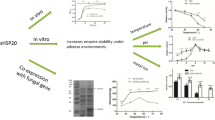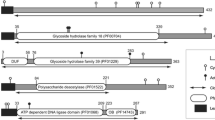Abstract
Objectives
A chaperonin, PsyGroELS, from the Antarctic psychrophilic bacterium Psychrobacter sp. PAMC21119, was examined for its role in cold adaptation when expressed in a mesophilic Escherichia coli strain.
Results
Growth of E. coli harboring PsyGroELS at 10 °C was increased compared to the control strain. A co-expression system using PsyGroELS was developed to increase productivity of the psychrophilic enzyme PsyEst9. PsyEst9 was cloned and expressed using three E. coli variants that co-expressed GroELS from PAMC21119, E. coli, or Oleispira antarctica RB8T. Co-expression with PsyGroELS was more effective for the production of PsyEst9 compared tothe other chaperonins.
Conclusion
PsyGroELS confers cold tolerance to E. coli, and shows potential as an effective co-expression system for the stable production of psychrophilic proteins.




Similar content being viewed by others
References
Cavicchioli R, Charlton T, Ertan H, Mohd Omar S, Siddiqui KS, Williams TJ (2011) Biotechnological uses of enzymes from psychrophiles. Microb Biotechnol 4:449–460
Clare DK, Vasishtan S, Stagg S, Quispe J, Farr GW, Topf M, Horwich AL, Saibil HR (2012) ATP-triggered conformational changes delineate substrate-binding and -folding mechanics of the GroEL chaperonin. Cell 149:113–123
Dahiya V, Chaudhuri TK (2014) Chaperones GroEL/GroES accelerate the refolding of a multidomain protein through modulating on-pathway intermediates. J Biol Chem 289:286–298
D’Amico S, Collins T, Marx JC, Feller G, Gerday C (2006) Psychrophilic microorganisms: challenges for life. EMBO Rep 7:385–389
Feller G, Thiry M, Gerday C (1990) Sequence of a lipase gene from the antarctic psychrotroph Moraxella TA144. Nucleic Acids Res 18:6431
Ferrer M, Chernikova TN, Yakimov MM, Golyshin PN, Timmis KN (2003) Chaperonins govern growth of Escherichia coli at low temperatures. Nat Biotech 21:1266–1267
Georgescauld F, Popova K, Gupta AJ, Bracher A, Engen JR, Hayer-Hartl M, Hartl FU (2014) GroEL/ES chaperonin modulates the mechanism and accelerates the rate of TIM-barrel domain folding. Cell 157:922–934
Hennequin C, Porcheray F, Waligora-Dupriet A, Collignon A, Barc M, Bourlioux P, Karjalainen T (2001) GroEL (Hsp60) of Clostridium difficile is involved in cell adherence. Microbiology 147:87–96
Jeong JY, Yim HS, Ryu JY, Lee HS, Lee JH, Seen DS, Kang SG (2012) One-step sequence- and ligation-independent cloning as a rapid and versatile cloning method for functional genomics studies. Appl Environ Microbiol 78:5440–5443
Kim SJ, Shin SC, Hong SG, Lee YM, Choi IG, Park H (2012) Genome sequence of a novel member of the genus Psychrobacter isolated from Antarctic soil. J Bacteriol 194:2403
Koike-Takeshita A, Arakawa T, Taguchi H, Shimamura T (2014) Crystal structure of a symmetric football-shaped GroEL:GroES-ATP complex determined at 3.8A reveals rearrangement between two GroEL rings. J Mol Biol 426:3634–3641
Kolaj O, Spada S, Robin S, Wall JG (2009) Use of folding modulators to improve heterologous protein production in Escherichia coli. Microb Cell Fact 8:9
Kupper M, Gupta SK, Feldhaar H, Gross R (2014) Versatile roles of the chaperonin GroEL in microorganism-insect interactions. FEMS Microbiol Lett 353:1–10
Machida K, Kono-Okada A, Hongo K, Mizobata T, Kawata Y (2008) Hydrophilic residues 526 KNDAAD 531 in the flexible C-terminal region of the chaperonin GroEL are critical for substrate protein folding within the central cavity. J Biol Chem 283:6886–6896
Nakamura T, Tanaka M, Maruyama A, Higashi Y, Kurusu Y (2004) A nonconserved carboxy-terminal segment of GroEL contributes to reaction temperature. Biosci Biotechnol Biochem 68:2498–2504
Tyagi NK, Fenton WA, Horwich AL (2009) GroEL/GroES cycling: ATP binds to an open ring before substrate protein favoring protein binding and production of the native state. Proc Natl Acad Sci USA 106:20264–20269
Warnecke T, Hurst LD (2010) GroEL dependency affects codon usage–support for a critical role of misfolding in gene evolution. Mol Syst Biol 6:340
Weber JK, Pande VS (2013) Functional understanding of solvent structure in GroEL cavity through dipole field analysis. J Chem Phys 138:165101
Xu Z, Horwich AL, Sigler PB (1997) The crystal structure of the asymmetric GroEL-GroES-(ADP)7 chaperonin complex. Nature 388:741–750
Yan X, Hu S, Guan YX, Yao SJ (2012) Coexpression of chaperonin GroEL/GroES markedly enhanced soluble and functional expression of recombinant human interferon-gamma in Escherichia coli. Appl Microbiol Biotechnol 93:1065–1074
Yoshimune K, Ninomiya Y, Wakayama M, Moriguchi M (2004) Molecular chaperones facilitate the soluble expression of N-acyl-d-amino acid amidohydrolases in Escherichia coli. J Ind Microbiol Biotechnol 31:421–426
Zhang W, Chen S, Liao Y, Wang D, Ding J, Wang Y, Ran X, Lu D, Zhu H (2013) Expression, purification, and characterization of formaldehyde dehydrogenase from Pseudomonas aeruginosa. Protein Expr Purif 92:208–213
Acknowledgments
This work was supported by Development of Cold-adapted Chaperonin GroEL/ES (PE13110), and the Antarctic Organisms: Cold-Adaptation Mechanisms (PE15070) funded from the Korea Polar Research Institute.
Author information
Authors and Affiliations
Corresponding author
Rights and permissions
About this article
Cite this article
Kim, HW., Wi, A.R., Jeon, B.W. et al. Cold adaptation of a psychrophilic chaperonin from Psychrobacter sp. and its application for heterologous protein expression. Biotechnol Lett 37, 1887–1893 (2015). https://doi.org/10.1007/s10529-015-1860-y
Received:
Accepted:
Published:
Issue Date:
DOI: https://doi.org/10.1007/s10529-015-1860-y




